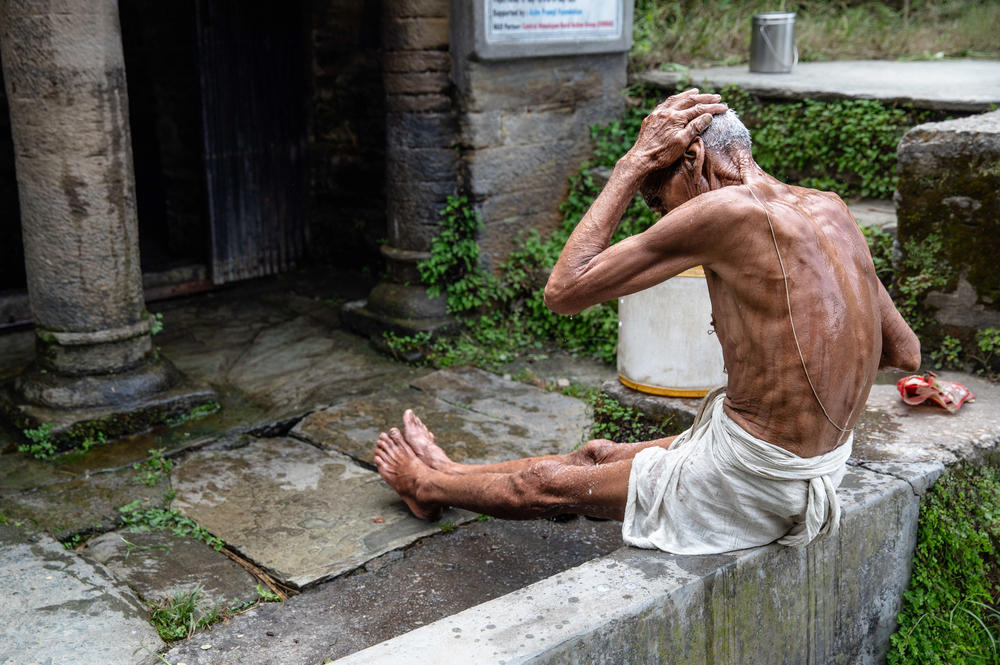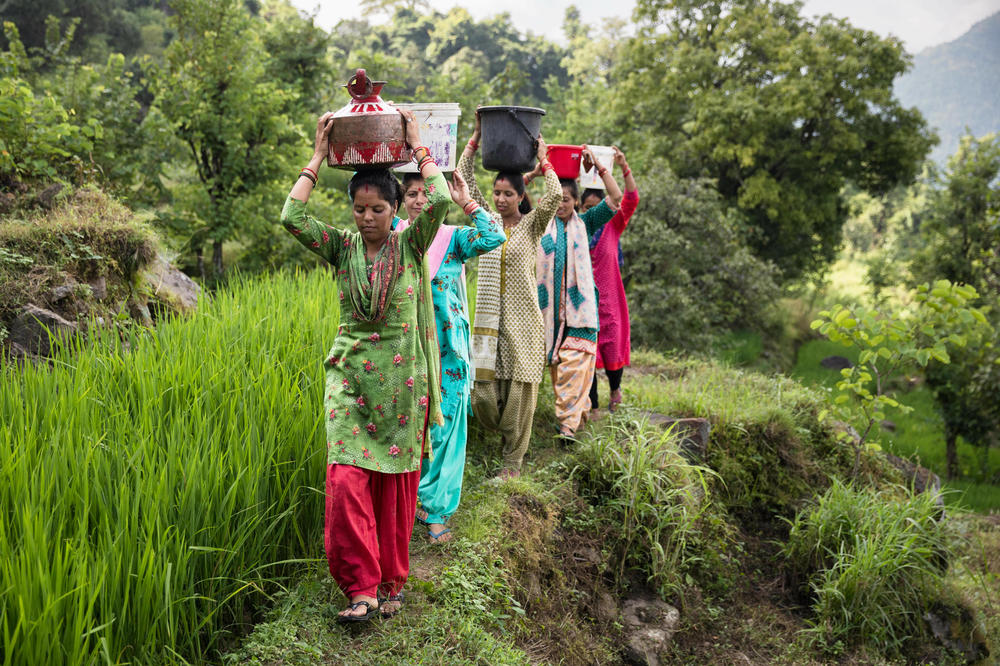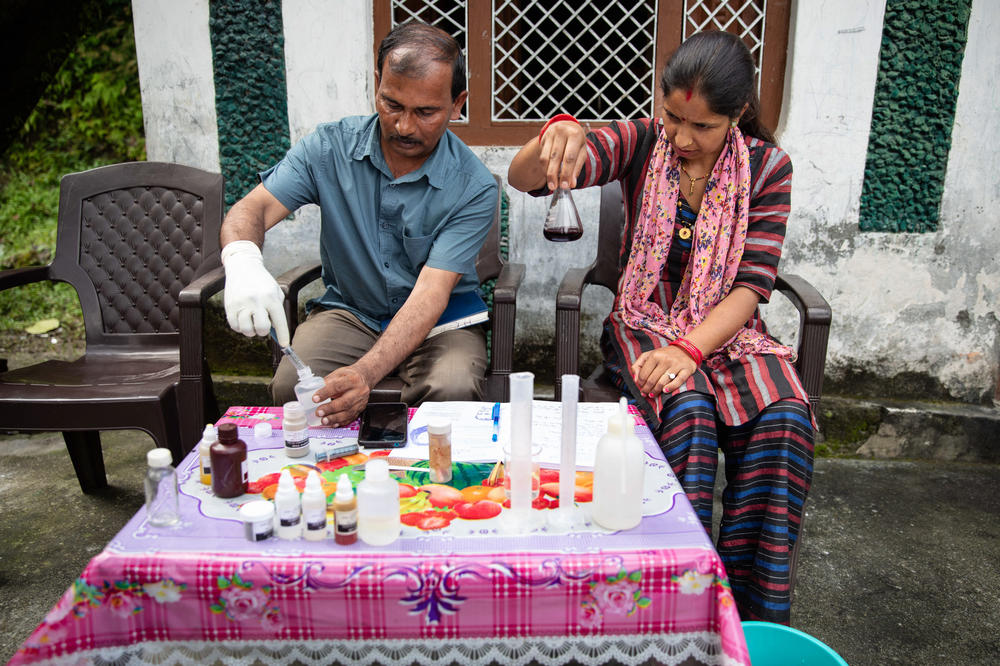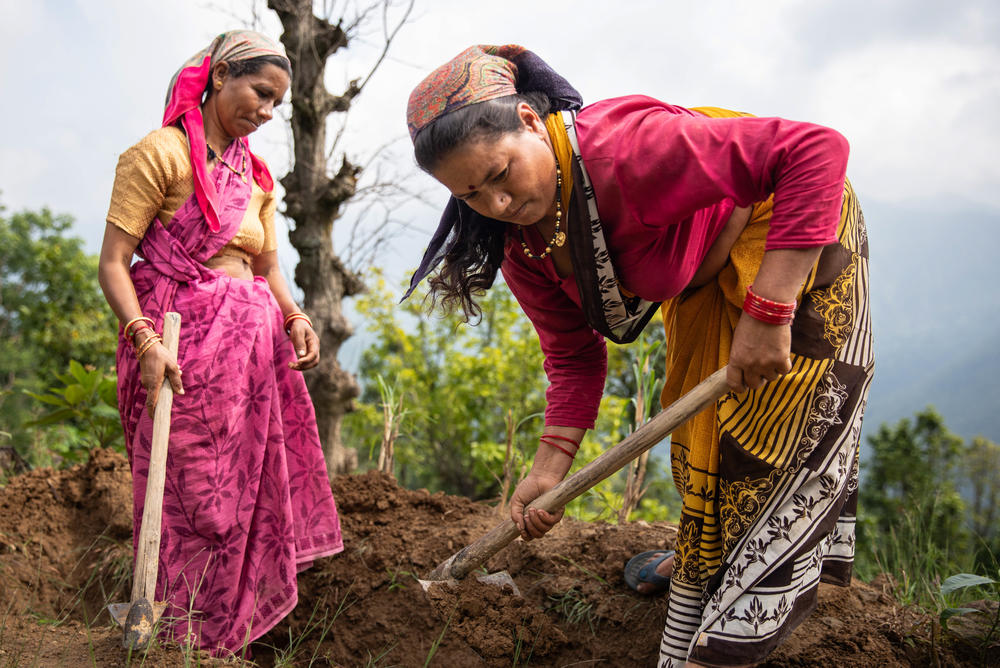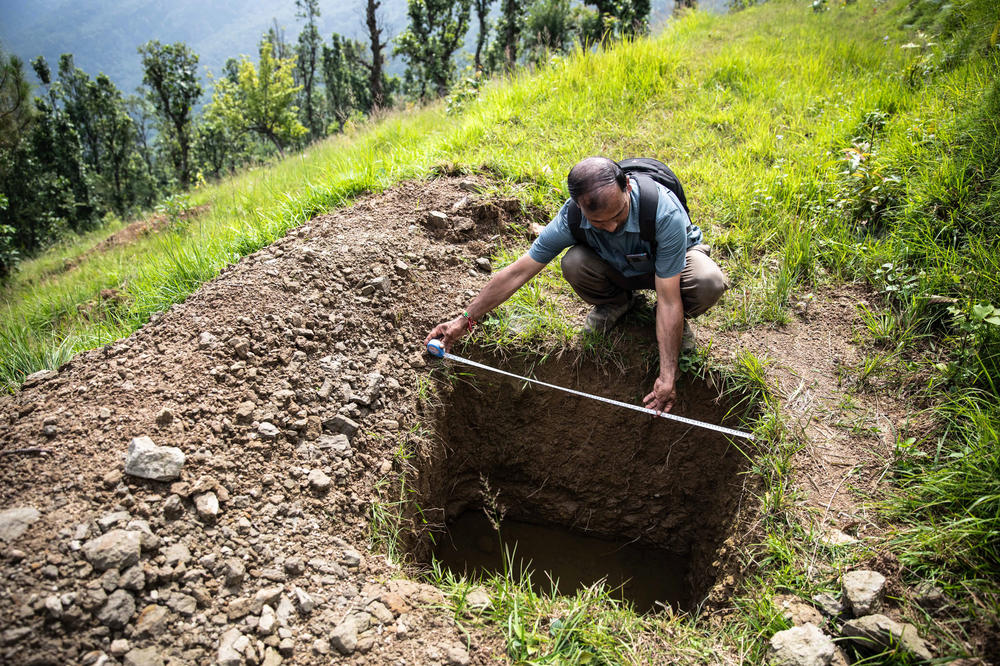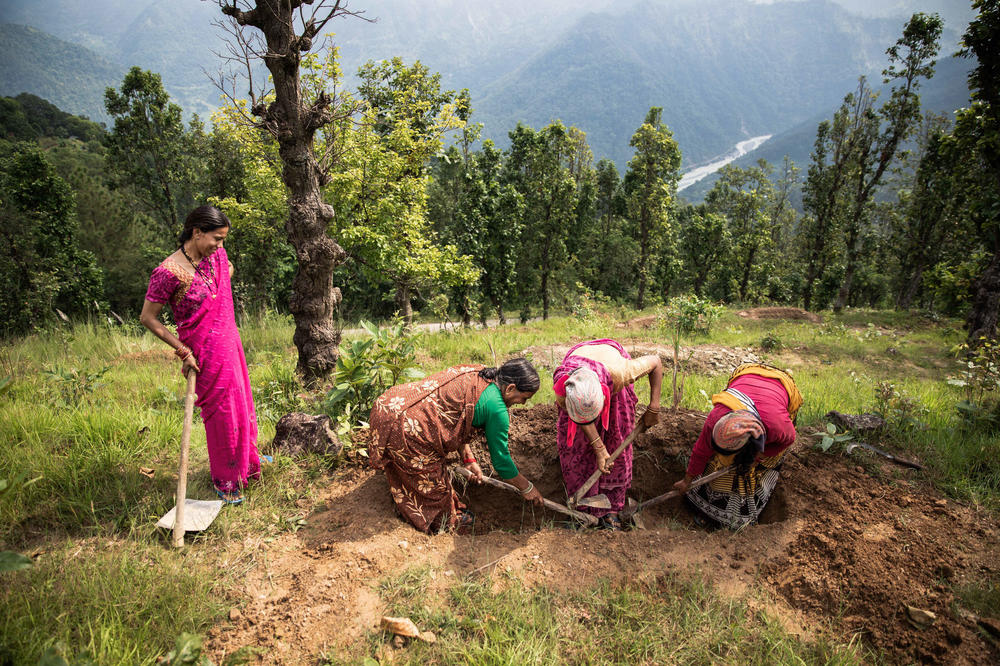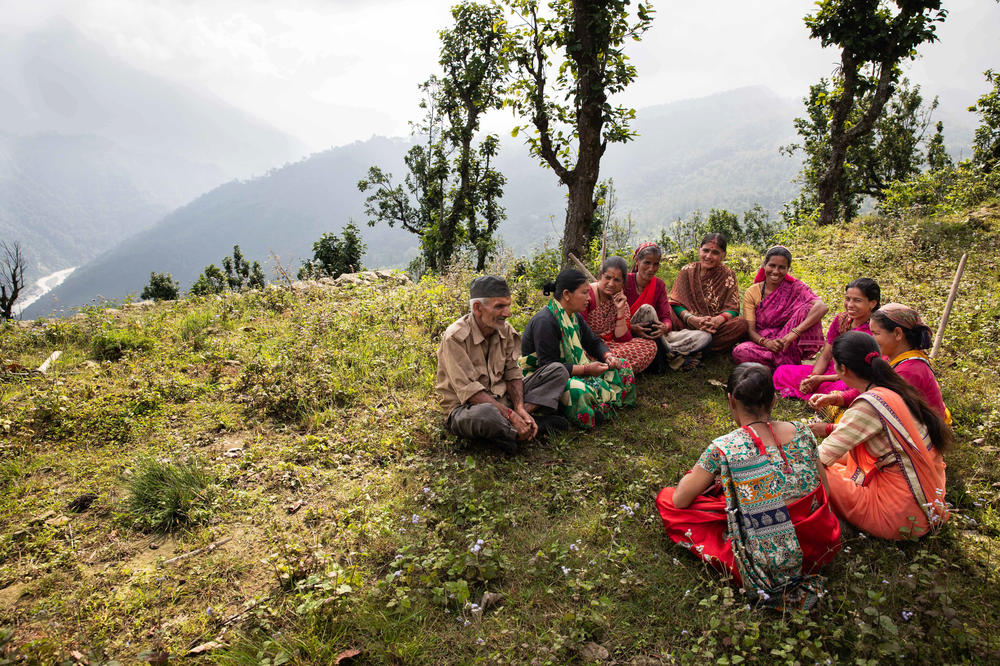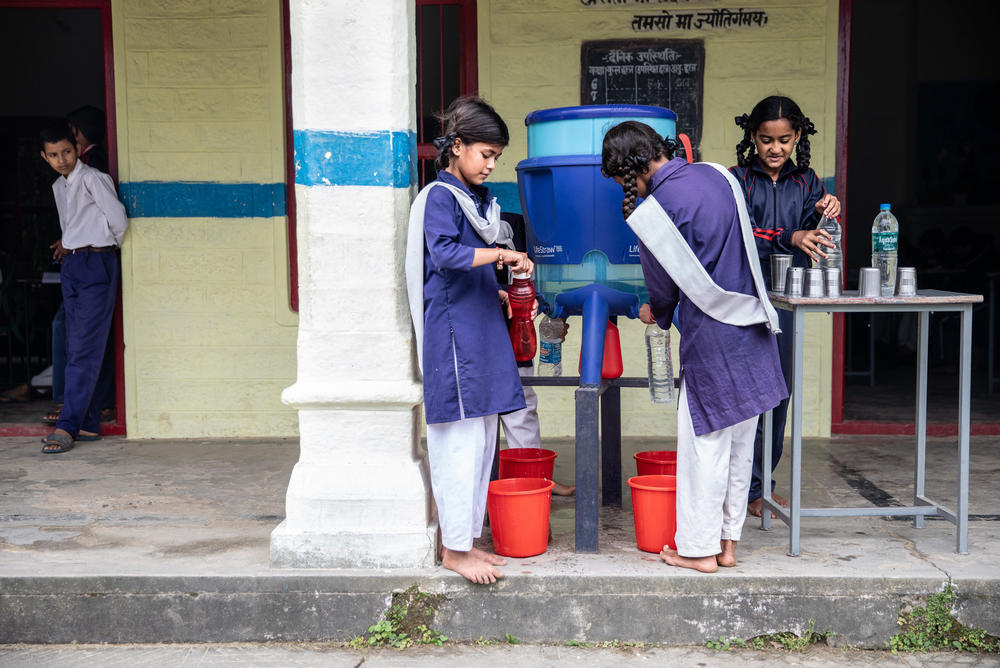Loading...
Section Branding
Header Content
As the 'water tower of Asia' dries out, villagers learn to recharge their springs
Primary Content
In a remote village in the Himalayan foothills, Kiran Joshi stands with a smartphone timer in one hand and a red plastic bucket in the other. Carefully, she places the bucket under a stream of flowing water and stops the timer once the bucket is full. She repeats the measurement three times to ensure the accuracy before looking up. "Thirteen seconds," she says.
Joshi is calculating the volume of water coming from a mountain spring in her village of Raushil in the state of Uttarakhand, India. There are roughly 3 million such springs emanating from the Indian Himalayan Region, but in 2017, the Indian government released a concerning report saying nearly half of them have run dry or are becoming seasonal.
As climate change exacerbates water scarcity issues in northern India, villagers like Joshi are fighting to revive these sources of spring water that millions of people depend on for survival.
On this sunny day in mid-September, Joshi calculates that the spring is flowing at 23 liters per minute — about 6 gallons. That's enough for the more than 10 families who count on it for their daily needs. It's evidence that the "spring recharge" efforts of Joshi and women like her are paying off. "Now that the water is available close to our homes, we are relieved," she says.
Living with water scarcity
In this mountainous region known as the "Water Tower of Asia," springs are often described as a lifeline. This is certainly true for the residents of the northern Indian state of Uttarakhand, who collect as much as 90% of their drinking water from mountain springs. And climate change is making the springs even more important.
"As temperatures rise and precipitation patterns becomes erratic, springs become an increasingly valuable source for water security," says Bandana Shakya, a landscape and ecosystem specialist at the International Centre for Integrated Mountain Development based in Nepal. "Especially in the mountains where the climate change impacts are really high."
Women are often tasked with fetching water for their families in these mountain regions, and they tend to be the most directly affected by water scarcity. Many of their husbands, meanwhile, have left these villages for bigger cities in search of higher-paying jobs, according to the state government.
Around here, women collect their water from small stone shelters called naulas that are often more than 100 years old. For generations, these spring-fed naulas have been revered for their importance to the community — with villagers placing small religious statues inside or building Hindu temples nearby. As the mountain springs began to dry up over the past two decades, however, women have been forced to walk further and further in search of naulas that still contain water.
Joshi says she used to travel almost two miles to and from other naulas, balancing 40 to 50 pounds of water in a vessel on her head on her return. "It was very difficult," Joshi says. "In the monsoons, the roads would get very slippery. There was always a chance that if someone fell, they would easily fracture a limb." She made this arduous journey four or five times a day to ensure there was enough water for cooking, cleaning and bathing and for the livestock as well.
Water security took a toll on the community's health. "My stomach used to hurt due to the weight of the water bucket on my head," Joshi says, adding that she and others feel their miscarriages and premature births were connected to carrying heavy water loads.
Approximately three years ago, this community's search for solutions led them to a development organization called the Central Himalayan Rural Action Group (CHIRAG). With time, CHIRAG members formed close working relationships with Joshi and others and offered technical support to help revive the springs in their region.
Women there say the results have made a noticeable improvement in their lives.
Spring "recharging"
Abhishek Likam, who leads the springshed management team at CHIRAG, says the first step to reviving the springs is understanding the problem: climate change has resulted in less rainwater penetrating the ground and refilling the natural aquifers. Ironically, a primary cause of the low water supply is too much rainfall all at once.
"We used to have rainfall in a very consistent span of 7-10 days. It used to be a kind of drizzle," Likam says. When that happens, "the water has more time to go under the ground and recharge the aquifer water systems."
Now, however, the region often experiences torrential rainfall over just a few days, which means "a negligible amount of water is going underground. A majority of the water is flowing off the surface." This results in the drying up of aquifers, leading to dried up springs.
To mitigate this effect, CHIRAG started organizing local women into "water user committees" and helping them conduct hydrogeological surveys. They traveled across the region to study the topography and determine which direction rainwater might flow as well as what might prevent rainwater from reaching the aquifers — critical information as they decide where to dig trenches and pits.
"Earlier I did not know how to identify a type of stone or which stones are obstructing water," Joshi says. "But through my training and my committee, I learned about this. My working knowledge improved."
This helped the group locate "catchment areas," or sections of land, often bounded by hills, where the rainfall has a high likelihood of draining into water bodies or penetrating the dirt and rock and replenishing the aquifers below. The more water that sinks into the ground here, the more likely it is to reach the underground aquifers and recharge the natural springs.
Once the group identified a catchment area, they undertook various efforts to slow down and trap the rainwater there, including digging different kinds of trenches, such as "contour trenches" and "percolation pits." Percolation refers to the filtering of liquid through a permeable substance. These trenches and pits help minimize surface water runoff and channel the rainwater into the soil, allowing it to filter through the ground and into the aquifers.
These efforts can have a substantial impact. The leader of another water user committee in the village, Manju Palariya, says she helped dig 100 contour trenches, which should add capacity for roughly 40,500 liters (nearly 10,700 gallons) more water in their aquifers. She also helped plant trees and build artificial ponds to foster better absorption of the water and benefit not only plant life but the small insects and larger animals in the area.
So far, according to CHIRAG, the organization has helped revive more than 600 springs in the Indian Himalayan region. That has allowed women there to access water far more easily — in their own neighborhoods rather than miles away.
Self-sufficient communities
By making tangible changes to the mountain landscapes — through planting, digging and building — villagers in the Himalayas have reshaped their environments to bring water back to their communities.
For communities with limited access to resources, Shakya, the landscape and ecosystem specialist, says reviving springs is especially cost-effective. They are "much more affordable than hard concrete infrastructure projects, such as building concrete water storage or water purification infrastructure."
And though many of the spring recharge projects receive a measure of outside funding, the women each contribute a small amount of money each month for project maintenance.
Over two years, Kiran Joshi's water committee has managed to save nearly $300 for projects like fixing water pipes or repairing the roof of their naula. CHIRAG says they eventually plan to take a step back, offering less technical support in these particular villages and allowing the women to use their knowledge of water science to make the decisions.
They also hope to equip the next generation with the knowledge to conserve and restore their precious water resources.
At a nearby school, CHIRAG has taught the students about water scarcity issues in the Himalayas. As they jostle to fill their bottles with spring water that reaches the school through water pipelines — using filters provided by CHIRAG to make sure the water is free of contaminants — many of the children speak thoughtfully about the impacts of climate change in their region.
"Due to the trenches [the women] have dug, the water table has increased. The earth has been able to absorb the water," says a teenage girl named Bhumi Sammal.
For young people like her, this progress means they've had more water to drink in the summers. It also means their communities have more tools to cope as climate change tests their region.
Namrata Kolachalam is a journalist based in Mumbai, India. She covers a range of topics relating to the environment, science and development. Her work has appeared in The Atlantic, Bloomberg, Slate and The Telegraph. She tweets at @NKolachalam.
Copyright 2023 NPR. To see more, visit https://www.npr.org.


